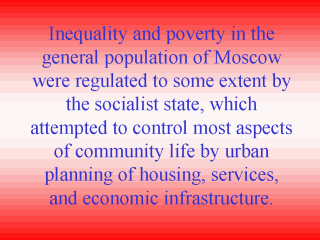 |
Moscow was
designed as a “model communist city”, homogeneous and “liberated” from problems
like segregation, ethnic living quarters, concentrations of poverty and wealth. This
strategy was only partly successful with the development in the 1950’s of the urban
micro-raiyon (administrative district). Micro-raiyons were nested hierarchically within
larger administrative districts, and larger urban zones. The planning of the micro-raiyon
included a self-contained neighborhood of about 15,000 people, with educational, cultural,
health, and retail services. Within raiyons, per capita norms were devised for services
and staff, such as square meters of shopping space, educational, health facilities, and
numbers of teachers and medical personnel. During the transition from a centrally planned
state to a market economy, the inner contrasts of lifestyles within Moscow raiyons were
amplified. |
